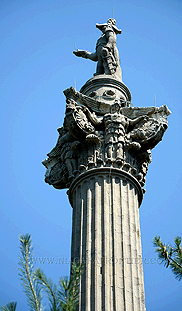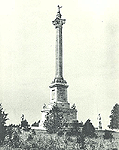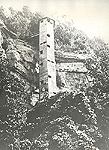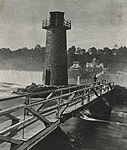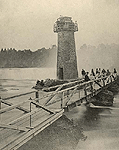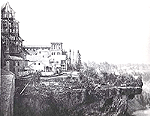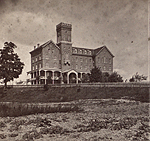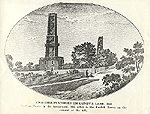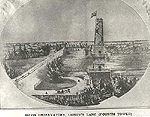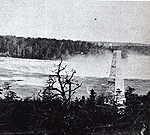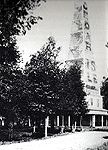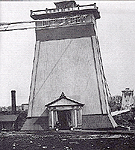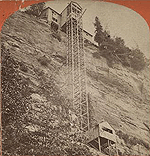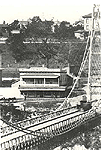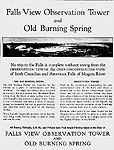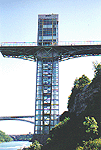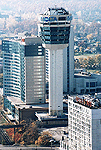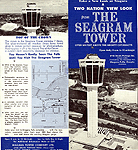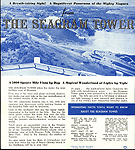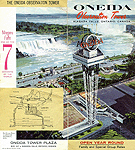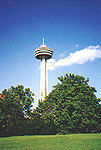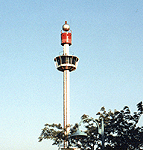The top of Brock's
Monument
1824 to Present a chronological history
From the beginning of the exploration of Niagara Falls to its subsequent development and tourism, man has endeavoured to find the best available site from which to view the mighty cataracts of Niagara. From seeking the highest ground amongst the surrounding landscape to building the tallest of man-made structures. This pursuit has combined human ingenuity, money and most modern technologies available to create a colourful History of the Towers of Niagara Falls. Since the mid 1800's, many hotels and museums built included cupolas and/or balconies from which visitors were able to view the Niagara Gorge and the Falls of Niagara. Several structures so built included the old Clifton House, Barnett's Museum/Table Rock on the Canadian side and the Cataract House on the American side. Today, modern hotels line the skyline overlooking the Falls of Niagara. These skyscraper hotels, some reaching 42 to 61 (proposed) storeys, have come to rival the existing towers and will become the benchmark for the building of future towers of Niagara Falls.
1824 BROCK'S MONUMENT
Brock's Monument
In 1824, the first monument memorializing British Major General Isaac Brock was erected at Queenston Heights. The white limestone tower was 65 feet (19.8m) tall. Inside this tower was a circular staircase inside the viewing area at the top of the tower. The bodies of Major General Brock and his aide de camp Lieutenant Colonel Macdonell were entombed at the base of this tower. The monument was dedicated on October 13th 1824. On April 17th 1838, Benjamin Lett, an Irish Canadian rebel sympathetic to the Mackenzie Rebellion and a group of saboteurs set off an explosive blast at the base of Brock's Monument causing irreparable structural damage. The bodies of Brock and Macdonell were disinterred from the vault and reburied in the Hamilton family cemetery in Queenston. On October 13th 1853, construction of the new Brock's Monument was begun. It was designed by Toronto architect, William Thomas. It was completed in the autumn of 1856. The tower is 184 feet (56m) tall and inside has a 235 step circular stairway to a small twelve foot diameter observation deck/pod at the top. It was paid for from public donations. At the beginning of the construction of the new monument, the remains of Brock and Macdonell were disinterred from the Hamilton cemetery and reburied in a vault underneath the monument. On April 5th 1929, during a heavy gale, the outstretched arm of the statue of General Brock broke off and fell to the ground below. It broke into three large pieces weighing one thousand pounds. The arm and the entire upper portion of the statue needed replacement. Scaffolding was build around the tower to the very top to allow workers to reconstruct the statue of General Brock. Brock's Monument continues to stand as a sentinel atop the Niagara Escarpment at Queenston overlooking the beautiful lower Niagara River area. Access to the top observation pod is allowed.
Brock's Monument in
1890
1827 BIDDLE STAIRCASE
The Biddle Stairs on
Goat Island
In 1827, Nicholas Biddle, a Philadelphia bank president and financier, underwrote the construction of a staircase from the top of Goat Island to the base of the gorge. They became known as the Biddle Stairs. The staircase was an eighty (80) feet tall wooden enclosed structure which contained a metal staircase. The stairs allowed visitors to descend into the gorge to the rocks at the base in order to provide a spectacular view of the Horseshoe Falls from below. At the base of this staircase, paths along the rock talus led to the edge of the Horseshoe Falls and to the Cave of the Winds attraction at the Bridal Veil Falls (Luna Falls). The Biddle Stairs contained small viewing portals to allow visitors a view of the Falls and the Niagara Gorge from differing heights as they descended or ascended the staircase. In 1847, a rock fall caused a large boulder approximately 400 square feet to fall into the gorge next to Biddle's Staircase nearly destroying this famous and favourite attraction. Biddle Staircase remained in operation for 98 years, before finally being demolished in 1927.
The Biddle Stairs on
Goat Island
1833 TERRAPIN POINT TOWER
Terrapin Tower
In 1816, General Peter Porter and his brother, Judge Augustus Porter were given possession of Goat Island. They retained this possession until 1885, when the land was reclaimed by the State of New York for the creation of the Niagara Reservation State Park. The Porter brothers built a bridge to Goat Island. At the entrance to their bridge, the Porters set up a toll gate collecting 25¢ from each person crossing this bridge for the privilege of viewing the Horseshoe Falls. At Terrapin Point (Porter's Bluff), the Porter brothers built a 300 foot long plank walkway which extended from the mainland of Goat Island to the crest line of the Horseshoe Falls. Built of heavy timbers, the walkway extended approximately ten feet beyond the crest line of the Falls. This overhang was frequently used by Francis Abbott, the Hermit of Niagara Falls who would entertain tourists by performing acrobatic acts at the very end of this walkway. The walkway was of slight construction and had no safety railings. Porter's Bluff is believed to have been the point from which Indian warriors in ages gone past, threw their sacrifices of war weapons and articles of personal adornment into the waters above the brink of the falls for the Great Spirit of Niagara. A few steps below this bluff are the Terrapin Rocks. In 1829, on several large exposed rocks near the end of this walkway, Terrapin Tower was built by General Parkhurst Whitney, a prominent American Innkeeper. It was the first of the towers at Niagara Falls to be built. Terrapin Tower was built in 1833 on Goat Island at the eastern edge of the Horseshoe Falls by Andrew J. Nichols. The circular shaped tower was forty (40) feet tall and twelve feet in diameter. It was constructed of rough stone which was gathered from the vicinity. Access to the tower cost an additional 10¢. It was gained through a single door at the base of the tower. A winding staircase led to an even smaller door at the top of this tower. At the top of this tower was a outside circular balcony guarded by a heavy metal railing. It provided an unparalleled view of the precipice and the boiling gorge below. In 1873, Terrapin Tower was purposely blown apart with the use of gun power. The tower was not destroyed because it had become unsafe, but rather not to compete with a planned new tower at the recently purchased Prospect Park by a new company. Those plans for a new tower subsequently fell through and the replacement tower was never built. Citizens tried unsuccessfully to get the Tower at Terrapin Point replaced. The timber walkway remained in existence for many years following the destruction of Terrapin Tower. It was still in existence as late as 1905.
the Terrapin Tower
1835 PROSPECT POINT OBSERVATION PLATFORM
In 1835, an observation structure was erected on Prospect Point. It was a simple unelaborated platform for viewing purposes. The viewing stage was ten (10) feet wide and twelve (12) feet long. The platform was extended over the edge of the Niagara Gorge by twenty (20) feet. Logs which supported this projection were long heavy tree trunks which extended from the base of the platform to the rock wall of the gorge. The flooring of the platform was made of stout planks. A heavy iron railing guarding the three sided of this viewing area. This observation platform stood until 1845, when it was removed for safety reasons. During its existence there were no accidents recorded.
1845 ROBINSON'S AMERICAN PAGODA
In 1845, Charles Robinson built a pagoda style observation tower. It stood on the bank of what was known for many years as "Hennepin's Point". This was the spot where Recollet priest, Father Louis Hennepin was suppose to have first viewed the Falls of Niagara from the American shore. Robinson's pagoda was one hundred (100) feet tall and was a sort of lookout surrounded by a low stone wall. It was a square shaped structure built of heavy timbers which were bolted together with cross beams. The outside of this tower was covered with a lattice veneer. This tower had three observation platforms at various heights as one climbed the tower on a steep zig-zag stairway built in the middle of this structure. This tower stood until 1860 when it was torn down.
1845 ANDERSON'S BATTLEFIELD TOWER
On March 15th 1815, a peace treaty was signed officially ending the state of war between the British and the Americans. The War of 1812 had come to an end and the Niagara Frontier laid in ruins. Next to the Falls of Niagara, the battlefields of the War of 1812 became the most popular tourist sites following the cessation of hostilities between the British and Americans The site of the bloodiest and deadliest battles of the entire War of 1812 occurred at the Battle of Lundy's Lane. This battlefield was the most infamous of the war and became an instant tourist attraction drawing curious people from both countries. At the Lundy's Lane battlefield, tours were given by war veterans. Captain Anderson was a short, stout retired British artillery soldier who fought in the battle of Lundy's Lane. He built a battlefield observation tower. It was the first of the battlefield towers to be built. In 1845, Captain Anderson built a forty (40) foot tall wooden observation tower overlooking the Lundy's Lane battleground. It was located along the north side of Lundy's Lane just north-east of the present day Drummond Hill Church. The tower was a crude wooden structure without a cellar or stone foundation. It was merely four logs placed in the sand, tapering at the top. The tower structure was covered with lattice work. Inside, a staircase allowed visitors to ascend to the top of the tower. The wooden posts decayed over time and on one particularly stormy night, the observatory collapsed. It was never rebuilt.
1846 McKENZIE'S BATTLEFIELD TOWER
On March 15th 1815, a peace treaty was signed officially ending the state of war between the British and the Americans. The War of 1812 had come to an end and the Niagara Frontier laid in ruins. Next to the Falls of Niagara, the battlefields of the War of 1812 became the most popular tourist sites following the cessation of hostilities between the British and Americans The site of the bloodiest and deadliest battles of the entire War of 1812 occurred at the Battle of Lundy's Lane. This battlefield was the most infamous of the war and became an instant tourist attraction drawing curious people from both countries. At the Lundy's Lane battlefield, tours were given by war veterans. Donald McKenzie was a direct descendent of Christopher Buchner, who had given the original ½ acre of land on Drummond Hill to be used as a burying ground which is presently part of Drummond Hill cemetery. In 1846, Donald McKenzie built the second battlefield tower on his property on the summit of Drummond Hill on the south side of Lundy's Lane. It was located in the vicinity of the present Drummond Hill Presbyterian Church Manse. It was build on land which was fenced enclosed and had been used at the time of the battle of Lundy's Lane as a funeral pyre for burning the dead soldiers bodies. McKenzie's tower rose from the top of a two storey weather boarded building. Around the top of the building was a promenade with a railing. From the top of the roof, built of heavy timbers projected the tower which was eighty (80) feet tall and tapered near the top. Approximately ¾ to the top was another wall around platform protected by balustrade. At the top of the tower was an outdoor observation deck with a telescope mounted on top of an iron stand. The top platform was protected with a perimeter railing. McKenzie had circulars printed which were distributed to visitors pointing out various points of interest. Access to the top of this tower was a zig-zag staircase in the center of the column. Inside the first floor of McKenzie's building were shelves displaying Indian bead work, moose hair work , bark work and bullets. McKenzie offered for sale a large collection of canes. From here, visitors bought various souvenirs. Access to the top observation platform cost tourists 25¢ each. For locals, access was free. In 1851, the observatory was enlarged. The tower was raised and it was made to look more attractive. On the night of July 4th 1851, McKenzie's Tower burned to the ground. Arson was suspected and was probably set by a competitor.
1847 ROBINSON'S CANADIAN
PAGODA
Robinson's Canadian
Pagoda (also known as the Camera Obscura )
In 1847, Charles Robinson built his second pagoda style observation tower. Robinson had owned land on the Canadian side of the Niagara Gorge between the Table Rock and where the Prospect Hotel stood for many years before the creation of the Queen Victoria Niagara Falls Park. This pagoda observation tower was seventy (70) feet tall and was built of the same style as its American cousin. It was a square shaped structure built of heavy timbers which were bolted together with cross beams. The outside of this tower was covered with a lattice veneer. This tower had three observation platforms at various heights as one climbed the tower on a steep zig-zag stairway built in the middle of this structure. This tower provided an excellent view of the Horseshoe Falls. The Pagoda also housed a camera obscura. This tower stood until 1860 when it was torn down.
1849 CHASM TOWER
Chasm Tower atop the Monteagle Hotel
The Chasm Tower was 75 feet high and was located above the five floor Monteagle Hotel. The Monteagle Hotel was built between 1848 and 1855 of stone by the Niagara Suspension Bridge House Company as a luxury tourist establishment on a 30 acre parcel of gardens and parks on high ground overlooking the village of Suspension Bridge and the Roebling Suspension Bridge spanning the Niagara River gorge. The hotel owned 2,000 feet of frontage along the eastern edge of the gorge a short distance north of the bridge. This tower known as the "Chasm Tower at Mount Eagle. It was erected in the summer of 1849, for the sole purpose of extending the view over one of the most interesting prospects in the world is built upon a knoll of land called Mount Eagle. It stands close to the perpendicular bank of the Niagara River. The top of the tower is about 200 feet above the water's edge provided an extensive overview of the gorge of the Niagara River and the surrounding scenery. It cost 12 1/2 cents to ascend the tower. The hotel and tower was destroyed by fire in 1936 and razed to the ground.
1850 FRALICK'S BATTLEFIELD TOWER
Durham Battlefield
Tower (foreground) & Fralick's Battlefield Tower
(background)
On March 15th 1815, a peace treaty was signed officially ending the state of war between the British and the Americans. The War of 1812 had come to an end and the Niagara Frontier laid in ruins. Next to the Falls of Niagara, the battlefields of the War of 1812 became the most popular tourist sites following the cessation of hostilities between the British and Americans The site of the bloodiest and deadliest battles of the entire War of 1812 occurred at the Battle of Lundy's Lane. This battlefield was the most infamous of the war and became an instant tourist attraction drawing curious people from both countries. At the Lundy's Lane battlefield, tours were given by war veterans. In 1850, Adam Fralick built a enclosed wooden tower just east of the tavern which he owned on the north side of Lundy's Lane directly across from the Lundy's Lane Presbyterian Church. It was visible for miles around. It was the third of the battlefield towers to be built. It was also built when the McKenzie Tower was still in existence across the street. Fralick and McKenzie became competitors. Fralick's tower consisted of a two storey building. From the top of the building rose a tower of frame construction. The tower was encased in lattice work. Fralick's tower stood longer than any of its predecessors. After many years, it finally fell victim to a severe storm which caused the tower to collapse. The house on which Fralick's tower rested atop, was repaired and subsequently occupied by a number of tenants. The house was later moved to a new location at Lundy's Lane at Dorchester Road.
1855 DURHAM BATTLEFIELD TOWER
The Davis/Durham
Battlefield Tower
On March 15th 1815, a peace treaty was signed officially ending the state of war between the British and the Americans. The War of 1812 had come to an end and the Niagara Frontier laid in ruins. Next to the Falls of Niagara, the battlefields of the War of 1812 became the most popular tourist sites following the cessation of hostilities between the British and Americans The site of the bloodiest and deadliest battles of the entire War of 1812 occurred at the Battle of Lundy's Lane. This battlefield was the most infamous of the war and became an instant tourist attraction drawing curious people from both countries. At the Lundy's Lane battlefield, tours were given by war veterans. In 1855, Mr. Davis built a tower known as the "Durham Tower" overlooking the battlefield. It was located on the north side of Lundy's Lane just east of Drummond Road. It was built as a plan of the Leonard estate. This was the fourth of the battlefield towers. It was built on slightly lower land so the tower would have to be built that much higher. The tower base consisted of a two storey brick building. The second floor was often used for community meetings and lodge meetings. This tower was later taken over and run by Mr. John Durham. Business remained good until the beginning of the American Civil War. The tower was still standing during the Fenian Raids. Residents were able to see parts of the battle of Ridgeway from the top of this tower. In 1870, several sections of this tower were destroyed during a wind storm. This tower was finally dismantled in 1870 and was never rebuilt. By 1891, none of the battlefield observation towers remained in existence.
1857 STREET'S CEDAR ISLAND PAGODA
Samuel Street's Pagoda Tower
In 1857, Samuel Street obtained a lease from the government for Cedar Island . Cedar Island was a small elongated island located approximately two hundred (200) yards upstream of the Horseshoe Falls along the Canadian shoreline. Cedar Island was later wiped out through land filling for hydro electric power development. Today, the remnants of what was once Cedar Island is located where the current site of the Canadian Niagara Power Company is situated. On Cedar Island, Samuel Street built a fifty (50) foot tall wooden pagoda styled tourist observation tower called "Street's Pagoda". The tower was mounted above a small house. Street's tower was a square shaped wooden structure covered in wooden lattice work and was very similar in style to those built previously by Charles Robinson. l The tower was too far from the brink of the Falls to offer a good view and was too off the regular path of tourists to become successful. As a result did not earn much money. The tower was still standing when Sutherland Macklem inherited the property in 1879.
Street's Cedar Island
Pagoda
1867 FALLS VIEW BRIDGE OBSERVATORY
the Falls View Bridge Observatory
The first Falls View Suspension Bridge was built by Samuel Keffer in the shadow of the Falls of Niagara. This bridge was of the suspension type with a timber deck and with stiffening truss and timber towers supporting the cables at each end of the bridge. The towers measuring one hundred (100) feet (30m) tall were built of 12 inch by 12 inch pine timbers. Each leg of the tower consisted of four timbers and the 16 were grouped together under the saddle plate for the support of the main cables. Guy wires were run from the bridge span to shore anchors to prevent the bridge from swaying. This bridge was completed and officially opened on January 4th 1869. Between 1872 and 1880 the bridge towers at each end of the bridge had been enclosed with wood and corrugated metal into a single structure. The top of the Canadian tower was outfitted as an outside observation platform at the top of this structure. Originally this tower was equipped with an internal stairway leading to the top. A steam powered "Otis" elevator was soon installed in the Canadian tower to take tourists to an enclosed observation deck at the top of the tower. Tourists could then walk up a flight of stairs to an outdoor promenade on the roof of the tower. The elevator ride cost 10 cents. Ultimately the view from this tower wasn't worth the cost and as a result this tower was not financially successful. In 1880, the towers were reconstructed to replace the wooden towers with steel towers. The elevator was abandoned and the observation deck not replaced.
1869 THE BUTTERY WHIRLPOOL RAPIDS ELEVATOR
the Buttery Whirlpool
Rapids Elevator
The Buttery Elevator was owned and operated by John Milton Buttery. Read more about the Buttery Whirlpool Rapids Elevator
1880 WARE'S FERRY OBSERVATORY
During the 1880's, a man named "Ware" was in charge of the ferry crossing the Niagara River. He erected an observatory on the top bank of the Niagara Gorge overlooking his ferry landing. At this area, there was a natural break in the edge of the cliff. The break in the landscape was later enlarged and extended backwards from the edge of the gorge in order to become the rail bed of the first incline railway at Niagara Falls. Ware's observatory was merely an enclosed space on the flat top of a one storey building which also served as the ticket office for the ferry and a curiosity store.
1883 HAWLEY'S BAZAAR & OBSERVATION TOWER
the Indian Bazaar
Building
The American Indian Bazaar building was located just south of the Upper Suspension Bridge. This building was originally built by Phillip Bender and was operated at one time by Captain Matthew Webb as "Captain Webb's Indian Bazaar. It was later renamed Hawley's Bazaar. Hawley constructed an observation tower on top of this building. It was used for several years before the entire building and observation tower was destroyed by fire. The Lafayette Hotel was later built upon this site.
1888 MOOSE TOWER OBSERVATORY
the Moose Tower In 1888, a two hundred and fifty (250) foot tall steel tower was built on the top of the Tower Hotel on River way on the American shore overlooking the American Falls near Prospect Point. The tower was fifty (50) feet square at its base. The tower which had several elevators and a seldom used stairway. It had three viewing platforms at differing heights. This was by far the tallest and most beautiful structure ever built in Niagara Falls until that time. The tower was a financial success. Snow and ice kept collecting on the open steel frame of this tower and ice kept falling onto the skylight of the museum located next to the tower. The tower was subsequently dismantled and moved following a bitter court battle. The Moose Tower at Prospect Point was moved to St. Louis and re-erected for the 1904 Louisiana Purchase Exposition. This tower was also used by Marconi to transmit one of the first wireless messages.
1893 LUNDY'S LANE BATTLEFIELD OBSERVATORY
the Lundy's Lane Steel
Tower
On March 15th 1815, a peace treaty was signed officially ending the state of war between the British and the Americans. The War of 1812 had come to an end and the Niagara Frontier laid in ruins. Next to the Falls of Niagara, the battlefields of the War of 1812 became the most popular tourist sites following the cessation of hostilities between the British and Americans The site of the bloodiest and deadliest battles of the entire War of 1812 occurred at the Battle of Lundy's Lane. This battlefield was the most infamous of the war and became an instant tourist attraction drawing curious people from both countries. At the Lundy's Lane battlefield, tours were given by war veterans. The fifth and final battlefield observation tower was built at the site of Fralick's tower by citizens of Drummondville. Officers of this community of Drummondville included: James A. Orchard, president Known as the Lundy's Lane Observatory, this steel frame tower stood 110 feet tall and had a Hall's Hydro - Steam driven elevator to take visitors to the top observation deck. The tower did make history because it was the first steel tower in Canada and it had no staircase. The elevator was a first for Niagara Falls. A second smaller observation deck was located at the 75 foot level of the tower. The use of this tower was short lived. It was never a paying proposition. The tower was idle from 1895 until it was dismantled in 1921. During the summer of 1901, the tower was opened for one day in order to raise funds to buy watches for local men returning home from the Boer War. Each visitor was charged 15¢ to ride to the top. On July 25th 1914, the tower was again opened for business for one day in order to mark the 100th Anniversary of the Battle of Lundy's Lane. This was the last time the tower was ever open. For many years the building housed the firm of Massey-Harris Farm Equipment Company. In 1921, Mr. William Crawford bought the tower and the building and later removed both.
1900 FRONTIER AMUSEMENT PARK TOWER
In the early 1900's, the Frontier Amusement Park occupied a five acre site along River Road between Bender Hill and Clifton Hill (property now occupied by Skyline Bock Hotel & Casino Niagara). This amusement park included a bandstand, roller rink, approximately twenty amusement rides, a tea garden, a wooden rollercoaster and bazaars. From the center of this amusement park rose a seventy (70) foot tall wooden observation tower. A center zig-zag staircase led visitors to the top of this tower. From here visitors were provided with an excellent view of the Niagara Gorge and the distant Falls. In 1909, the Frontier Amusement Park went into receivership and the amusements including the observation tower were torn down.
1920 BURNING SPRINGS OBSERVATION TOWER
The Falls View
Observation Tower and Burning Springs
In the early 1900's, when the Ontario Power Company took over the entrance to Dufferin Islands, the famous burning springs was disposed of its historical location and moved to its new site located atop the Falls View area along the moraine overlooking the Horseshoe Falls. Here promoters built a large two storey structure which housed a glass enclosed observation deck on the top floor along with an observation cupola. Following the building of the Seagram Tower in 1961, the Falls View Burning Spring building was converted to a museum. This structure remained in existence until it was torn down in the late 1970's.
An original promotional
pamphlet for the Falls View Observation Tower and Burning Springs
1939 proposed Clifton Hill Tower
In August of 1939, Sir Harry Oakes suggested the building of a tower measuring three hundred and fifty (350) feet to be built on Clifton Hill along with a convention center with a capacity of ten thousand (10,000) people. The tower was to have been built on Clifton Hill where the Bush mansion once stood. This proposal was put forth by C. R. Morden but was never acted upon.
1958 PROSPECT POINT OBSERVATION TOWER
the Prospect Point
Observation Tower In the Fall of 1958, construction began on a two hundred and eighty-two (282) foot tall steel and glass observation tower at Prospect Point overlooking the American Falls. The tower was designed as an observation deck which was accessible from the mainland and an elevator shaft to the base of the Niagara Gorge and the Maid of the Mist Boat docks. Construction was carried out by the White Plains Iron Works Company at a cost of one million - two hundred and fifty thousand ($1,250,000) dollars. The base of the tower just above the river is hexagonal in shape measuring thirty-four (34) feet high and sixty (60) feet wide. This structure is built into the gorge wall to provide a better sight line. On the top of the foundation is the one hundred and sixty - five foot tall steel and glass shaft. The tower is formed in the shape of a Maltese Cross. The tower contained two elevators with five utility levels rising another eighty - four (84) feet above the main observation deck . The Prospect Point Observation Tower was officially opened in February 1961. This tower is currently in service.
the Prospect Point
Observation Tower
1960 proposed Bottle Shaped Tower
In the Spring of 1960, the Creative Engineering Designs Company of Toronto proposed the building of a bottle shaped observation tower measuring three hundred and forty (340) feet overlooking the Falls of Niagara. This proposed project also included a convention center with a capacity of 2,500 people. Approval of this proposed project was never secured and was it was never carried out.
1960 proposed Global Center Tower
In December of 1960, US and Canadian businessmen, George Sainovich and John Gruyich proposed the building of the Global Center Observation Tower to be build on land owned by Mr. Sainovich overlooking the Falls. The tower would measure four hundred and eighty (480) feet tall and would contain a combination observation deck, observation lounge and a revolving restaurant. The restaurant would rotate once every hour. the project also included plans for a two to three thousand person convention center. The project which was estimated at twenty-five to thirty-five million dollars was never carried out.
1961 SEAGRAM TOWER
the Minolta Tower in
1999
On March 15th 1961, construction began on the Seagram Tower. It was completed on June 1st 1962 at a cost of $1.2 million dollars. This project was conceived by Niagara Tower Limited, a group of Niagara Falls businessmen led by company president, Mr. C. H. Augspurger of Buffalo, New York. Mr. Augspurger approached the House of Seagram Company of Montreal for major funding of this project. The House of Seagram was a Canadian Distillery famous for its production of "Crown Royal" whiskey. It became a main contributor to this tower development. The tower was built by Byer's Construction Company of Montreal under the guidance of project engineer, Ian Tindal. The project superintendant was Maurice Huneault. It was designed by Horton and Bell Architects of Kitchener, Ontario. The tower was developed on a 1.8 acre site on the top of the moraine overlooking the Horseshoe Falls (area known as the Fallsview Tourist District). The tower would measure three hundred and twenty-five (325) feet tall. The tower was six hundred and fifty-five (655) feet above the base of the Horseshoe Falls. The top of the flag pole is nine hundred and thirty-two feet above sea level. Weighing nineteen million pounds, the Seagram Tower contains three thousand cubic feet of concrete and four hundred and fifty thousand pounds of structural and reinforcing steel. The one hundred and ninety-five (195) foot tall - thirty feet (30) diameter concrete and steel hexagon shaped column was capped by a seven storey crown shaped - seventy foot diameter combination indoor/outdoor observation decks, restaurant, lounge and tourist facilities. The tower boasted three crows nest style open observation decks and one enclosed observation area. The outdoor summit platform is one thousand square feet in size. The fourth floor is completely enclosed in glass specially designed for taking photographs, having built in light meters and tinted glass to reduce glare and reflections. It also contained three elevators and two stairways. The elevators were designed to carry up to 900 persons each hour. The tower was constructed utilizing a "concretor" Linden climbing crane in a "slip form" construction technique. The slip form technique was the first time it was used in North America. A similar technique was later used during the building of the Skylon Tower. Concrete was poured six inches at a time in a counter clockwise motion. This was done to counter the natural clockwise motion of the form. An empty crane bucket weighed 560 pounds. This bucket carried up to a ton of concrete with each lift. Thirty-eight giant hydraulic jacks were used to lift the yoke and platform mount up the stem as the tower rose. The tower stem is thirty feet in diameter and was constructed with thousands of tons of steel reinforcing rods. During the building of the tower, the stem rose one inch every 12 minutes. Work was carried out twenty-four hours a day. The sixty foot deep concrete and steel base was poured after a twenty foot deep hole was excavated. The base was anchored into the ground by driving 276 - "H" steel beams approximately 12½ feet into the ground. Each pile beam weighed a ¼ ton. Seagram Tower was designed to provide for a one and three quarter (1.75) inch sway at the top of this tower in order to absorb stress. On Saturday September 2nd 1961 at approximately 2:30 a.m., the top of the tower caught fire when two labourers, Donald Meisner and Ivan Stanic, both of Niagara Falls were pouring hot mix concrete at the second level of the seven floor upper crown. As they did so, a tarpaulin covering freshly poured cement caught fire. This fire quickly spread to the wooded forms and several propane tanks exploded. It took firefighters six hours to extinguish the stubborn blaze. Four workers and five firemen received minor injuries. The fire caused damage to a huge section of the slip form and it caused the 60 foot long Linden crane to topple to the ground below. Damage was estimated at a few thousand dollars and described as having very minor consequences by owner, Mr. Augspurger. Throughout the years, this tower has had numerous owners and names. It has survived several bankruptcies and the threats by the City of Niagara Falls of taking possession because of overdue back taxes. Name changes included Seagram Tower, Royal Inn Tower, Heritage Tower, Panasonic Tower and Minolta Tower. In 1966, Mr. Louis Bolus and Arthur White, both Niagara Falls businessmen, became the principal owners of the Seagram Tower. On May 1st 1969, the tower renamed the Heritage Tower when purchased by majority shareholder, Mr. Louis Bolus. Heritage Restaurants, a division of Versa Foods leased the restaurant facilities in the tower. In 1971, the tower became known as the Royal Inn Tower under the ownership of Royal Inns of Canada. President R. Ian MacDonald announced a plan for the 4.5 million dollar hotel complex to be built around the base of the tower. These plans never materialized. On June 16th 1972, the Royal Inn Tower went bankrupt. Ownership of the tower reverted back to the Bolus Management Company. On August 6th 1972, the Royal Inn Tower became the "Royal Center Tower. The tower was owned by the company of Bolus, Revelas & Bolus Limited. In March of 1973, the name of the tower was changed to the "Panasonic Tower". The Panasonic Tower name was leased by the Matsushita Electric Company of Japan. In addition, office space on the 30th floor was reserved. On October 9th 1976, in order to prevent bankruptcy, Arthur White of White Holdings sold his shares of the Panasonic Tower complex including an aquarium and museum to Takeshi Shimizu, Canadian president of the Panasonic Company. By December of 1976, the Panasonic Tower was in severe financial difficulty. Back taxes amounting to $100,000 was owed to the City of Niagara Falls. On October 6th 1977, in an effort to collect back taxes from the Royal Center Incorporated, Louis Bolus closed the Panasonic Tower. Forty employees were laid-off. On October 14th 1977, the Panasonic Tower was re-opened for business. In January 1978, the tower was again bankrupt. In 1979, the tower remained in tax arrears. In 1980, the City of Niagara Falls threatened to take over the tower. By this time the tower owed the city approximately $320,000. In April 1981, Betty Bolus and Len Wodlinger became the new private owners of the Panasonic Tower. On April 10th 1984, the tower became known as the Minolta Tower. The name was leased to the Minolta Company of Canada. On January 15th 1993, the Minolta Tower was sold to Radomat Holdings of Niagara Falls, New York. The new owners were Dragan Matovic and his brother Nick Matovic. This company also owned the Raddison Hotel and the Holiday Inn in Niagara Falls, New York. The Minolta Tower is currently in service as a hotel.
the original Seagram
Tower brochure
1964 ONEIDA TOWER
the original Oneida
Tower brochure
The Oneida Community was established in 1848 at Oneida, New York by John Humphrey Noyes. This was perhaps the first communal community established in North America. In 1877, a segment of this community began making and selling iron spoons in order to make a living. In 1880, this Oneida Community broke apart. A segment of the Oneida's continued to manufacture spoons. This segment of this community under the leadership of John Noyes and his ancestors established the Oneida Silversmith Factory in Niagara Falls in 1926. They owned a large tract of land along the north side of Clifton Hill where they built a manufacturing business including offices and a factory. In 1963, the Oneida Community Developments Company (Canada) Limited decided to further develop its Niagara Falls property by building a tower and commercial stores in a complex facing Falls Avenue. Under the direction of then company president, Pierrepont T. Noyes, an observation tower measuring three hundred and forty-one (341) feet tall was built. The top of the flag mast was three hundred and fifty-five (355) above Falls Avenue. This tower and commercial complex was designed by architect Alan R. Moody. It was constructed in six months by the Frankel Steel Company of Toronto. A building crane with a two hundred and ninety foot long boom was used to build this steel and glass structure. The base of this tower was created utilizing 350 tons of steel embedded into four concrete - sixteen foot square cubes of concrete. Each block weighed 300 tons, each of which was anchored into the bedrock. Construction progressed at a rate of six feet per day. The top of this tower was capped with a two storey observation deck capable of holding 1,500 people at a time. Two glass enclosed elevators at the center of this tower were capable of carrying 1,800 people per hour. The fifty second long elevator ride would take passengers two hundred and seventy-eight (278) feet to the lower observation level. From this lower deck, people could walk up to the top observation deck located ten feet above. The upper deck was a partially open, providing people with excellent views of the Falls through special openings in the wire mesh fencing and to provide for the taking of pictures. In case of emergencies, both elevators which were built side by side had side entrances. In the case that one elevator became stuck, the other could be maneuvered beside the stranded elevator and the passengers transferred from the stricken elevator and safely returned to the ground level. A 500 step stairway for emergency use only was also available. This tower was built of an open steel frame construction and was the first of its construction type ever built in Canada. In addition to the tower, a five store - two storey commercial plaza was built at the base. The cost of this project was ten (10) million dollars of which the tower cost one million dollars. At night this tower was illuminated in a manner so that just the observation decks were lighted giving the appearance that it was hanging in mid-air. A giant fifty foot by thirty foot neon company sign adorned the top of this tower. In 1974, this sign was removed because rust had rendered it unsafe. The tower was completed in June 1964. Price of admission to the observation deck was $1 per adult and 25¢ per child. In 1974, the Oneida Tower became known as the Niagara Tower and Plaza Limited. In 1985, this tower would become the center piece of the Maple leaf Village Shopping Complex under the name of "Kodak Tower".
the Oneida Tower in 1964
1964 proposed New
International Center Tower
In June of 1964, an observation tower measuring five hundred (500) feet tall was proposed to be built at a location yet to be determined overlooking the Falls of Niagara on the Canadian side. The planned tower was to be patterned after the Century 21 Space Needle Tower in Seattle, Washington. The three legged tower would have an observation deck with a revolving restaurant which would make one complete revolution per hour. At the base of this tower, plans were made for a huge exhibition area. Passengers would be whisked to the top observation deck by high speed elevators which would run along the outside of the tower. The elevator cages would be replaced with windows.
1964 SKYLON TOWER
the Skylon Tower
The Skylon Tower project was developed by W.P. Piggott of Piggott's Construction of Hamilton, Ontario, Richard V. Reese of Niagara Falls, New York (formerly of the Reese's Candy Company of Hershey, Pennsylvania) and William Young of the Hamilton Cotton Company, of Hamilton, Ontario. The tallest structure in Niagara Falls cost $7 million dollars to build. It was originally known as the New International Center Tower by its parent company. The company officials included: William Pigott, Chairman of the Board Property for the project was leased from Mr. George Sainovich and the New York Central Railway. A portion of Warren Street, a City of Niagara Falls right of way was leased for 99 years at a cost of $500 per year. The Skylon Tower was designed by the architectural firm of Bregman and Hamann of Toronto, Ontario. The tower was inspired by the Space Needle Tower in Seattle, Washington. It was built by the general contractor: Piggott's Construction Company. The chief architect was Kaljo Voore. On site consulting engineers were provided by H.G. Acres & Company. Mechanical and electrical engineering consultants were provided by Grenok, Chisvin & Company of Toronto. Prior to construction, wind tests were conducted by experts at the University of Toronto. Consulting structural engineers were provided by the company Farkas, Barron & Jablonsky of Toronto and New York. In May of 1964, construction began on the Skylon Tower measuring five hundred (520) feet tall on land atop the moraine overlooking the Falls of Niagara between Murray Street and Robinson Street in Niagara Falls, Ontario. Including the mast at the top, this tower measures five hundred and twenty (520) feet above ground level and seven hundred and seventy five (775) feet above the base of the Falls. The top mast measures forty three (43) feet tall. Because the tower is so tall and so close to an international border, approval to build this tower was needed from air transport authorities from both Canada and the United States. The tower is designed to withstand winds up to 110 miles per hour (mph). The maximum wind recorded was 91 miles per hour (mph). The average wind speed is 14.5 miles per hour (mph). This tower contained a three storey globe at the top of the tower containing an indoor/outdoor observation deck, a revolving restaurant and stationary buffet restaurant. This globe according to the designer's represented the Northern Hemisphere. At the base of this tower was a large sixty-five foot tall - 105,000 square feet, three level exhibition complex including stores, restaurants and lounges. The foundation for the tower is forty-five feet deep and is ninety-four feet in diameter at its bottom and one hundred and sixty feet in diameter at its top. Three hundred tons of steel was used in the foundation. Slab cement was utilized with eight inch thick steel reinforced forms. The pad utilized 6,000 tons of concrete. The building of the Skylon Tower represented the second time that a "slip-form" construction technique was utilized. It had been previously been used in the building of the Seagram Tower. The unique aspect of this slip-form construction at this tower was the difficulty encountered using this technique with a tower that tapered at the top so that as the slip form was raised it also had to be proportionately reduced in diameter. This was a first in the construction industry. The base of the center column measures 72.6
feet in diameter A 35 ton Linden Crane with a 100 foot long boom was used to lift the concrete and supplies into place. This crane which cost $45,000 was able to lift 5,500 pound each time. At the end of construction, the Linden crane was removed from the top of the tower by cargo helicopter. Slip-form concrete began pouring on September 23rd 1964. Concrete was poured continuously for thirty-eight days - twenty-four hours a day. The slip-form, 40 inches in height, was inched upward by 15 hydraulic jacks, each weighing 2 tons, which pulled the entire form one inch every 10 minutes of the 38 days with almost 6,000 cubic yards of concrete being placed in the continuous pour. The tower rose six inches per hour or twelve feet per day. The column contains 12,000 tons of concrete and 800 tons of steel. One of the most challenging engineering feats was the construction and placement of the Dome at the top of the shaft. The circular form for the base of the Dome, 108 feet in diameter, was assembled at ground level around the Tower. Then, this form, weighing 120 tons, was raised 380 feet in the air. A method of using hydraulic jacks and jacking rods operated from the top of the shaft was devised to accomplish this construction feat in only eight days. The widest part of the globe at the top of this tower measures 108.8 feet in diameter. At the top of the column, this form was fastened into place by 36 - 2½ inch diameter X 25 feet long bolts. It served as the base form of the globe. Once at the top, the globe form was reinforced with 125 tons of steel and 800 yards of concrete. The grey concrete and steel tri-legged tower supports the globe at the top. In a cross-section, the tower is "Y" shaped with a shafts for the stairs located at the intersection of these legs. Each leg is a hollow trapezoid, that diminishes in section as it rises. Two - 2 foot thick radial walls and a 4 foot thick cross wall set back three feet from the exterior wall form the three sides of the trapezoid. The interior end wall is formed by the shaft enclosing the stairwells. At the base, the end surfaces of the radial walls are 36 feet from the center of the column. At the base of the globe at the top of the column, this distance is only 17 feet. The tower has three high speed elevators which ride on the outside of the tower on rails mounted on the outside walls of the column between the three legs. This was Canada's first outside elevator. It was designed and engineered by Otis Elevators Limited of Hamilton, Ontario. Each elevator which is capable of holding 30 people is glass enclosed to provide maximum sight lines as it ascends or descends at 500 feet per minute. Each elevator is painted bright yellow and are very visible. The exterior of the elevator is comprised of a weather resistant plastic coating. Tempered glass on these elevators are capable of resisting 100 mile per hour (mph) winds. The roof of the elevator machine room is 465 feet above the ground. In addition to the elevators, this tower has two separate 662 step zig-zag staircases leading to the lowest level on the globe at the top of the tower. The 300 person revolving dining room makes one complete rotation every hour. The rotating floor which rests on a circular rail is propelled by a 3 horsepower (HP) motor. On October 28th 1964, the tower was officially named the "Skylon Tower". Although not listed in the dictionary, then company president, Edward Bull Jr., described the name as meaning "space aged version of a skyscraper". On May 21st 1965, a fire erupted on the roof of the exhibition complex at the base of the tower. The fire started at approximately 6:29 p.m. The fire was contained to a 6,000 square foot area of tarred beaver-board. The cause of the fire was unknown and no one was injured. Damage was estimated at $5,000 dollars. On June 12th 1965, the base form of the globe was slowly lowered at a rate of forty feet per day. This form was used by painters to paint the tower as it was lowered to the ground. On September 31st 1965, the Skylon Tower was officially opened. Canadian Pacific (CP) Hotels held the contract to operate dining facilities at three locations within the tower. On October 1st 1975, Canadian Pacific (CP) Hotels purchased the Skylon Tower complex for $11 million dollars. The land on which the tower rests was not purchased but continues to be leased for a long term. On August 7th 1974, the Skylon Tower and it's owners - Canadian Pacific announced the sponsorship of the first annual Skylon Marathon between Buffalo, New York and Niagara Falls, Ontario, a distance of approximately 26 miles to take place in October. On June 21st 1985, two unidentified men parachuted from the top observation deck of the Skylon Tower to the ground below. No one was injured. This became a first of a series of thrill seekers to follow a sport known as "base jumping". On October 19th 1985, Canadian Pacific Hotels put the Skylon Tower up for sale. The sale price is $20 million dollars. Canadian Pacific Hotels continued to operated the Skylon Tower complex until 1986 when it was sold. The Skylon Tower was sold to Niagara Falls businessmen, Mr. George Yerich and Mr. John Gruyich. Mr. Yerich was the owner of the Holiday Inn by the Falls Motel and Mr. Gruyich was the owner of Michael's Inn. In April of 1986, the Skylon closed its indoor amusement park because of the high cost of insurance. On June 2nd 1986, David Hicks became the 3rd person to successfully parachute from the observation deck of the tower. On December 10th 1988, Mr. George Yerich became the sole owner of the Skylon Tower complex. This tower is currently in service. During 1999, at least five persons have parachuted from the observation deck of this tower to the ground below. No one was injured. This activity known as "Base Jumping". This activity is not only dangerous but it is illegal. Since its construction in 1964, two persons have
committed suicide by jumping to their deaths from the observation deck.
1967 SPACE SPIRAL TOWER - CLIFTON HILL
the Space Spiral Tower
In January 1967 Mr. Malcolm Howe, the proprietor of the Movieland Wax Museum proposed the build of an observation tower on Clifton Hill. The tower was built on property owned by Welland Securities Property (19640) Limited. The property was located along the south side of Clifton Hill half way between Victoria Avenue and Falls Avenue. The tower measuring one hundred and eighty-four (184) feet tall was named the "Space Spiral". It was built by the Universal Design Company of Wildwood, New Jersey. The 30 person gondola rotated along the one hundred and fifty foot tall shaft as it ascended or descended. This tower is currently in service under the management of HOCO Entertainment & Resorts and is known as the "Falls Tower". The tower was decommissioned after October 9th 2006. On November 23rd 2006, the tower was dismantled to make way for new development.
Date last updated:
March 16, 2016
THANK YOU FOR VISITING
a
history
|
|||||||||||||||||||||||||||||||||||||||||||||||||||||||||||||||||||||||||||||||||||||||||||||||||||
